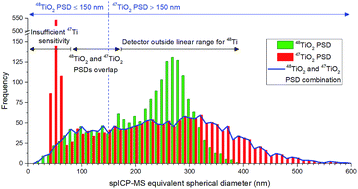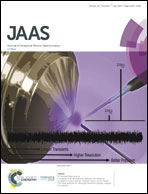Combination of 47Ti and 48Ti for the determination of highly polydisperse TiO2 particle size distributions by spICP-MS†
Abstract
Food-grade titanium dioxide (TiO2), also known as the E171 additive, consists of a white water-insoluble powder commonly used as a food coloring and opacifying agent in various sweets and confectionery. It is usually found to be highly polydisperse with sizes ranging from 30 nm up to 500 nm. While the interest in determining the nano-sized fraction (i.e. <100 nm) of this additive is growing, its polydispersity makes the establishment of a complete particle size distribution (PSD) by single particle inductively coupled plasma mass spectrometry (spICP-MS) particularly challenging. Currently, most spICP-MS studies of TiO2 particles rely on the measurement of a single titanium isotope (e.g.48Ti, 47Ti or 49Ti). On the one hand, 48Ti is the most sensitive isotope and therefore gives access to the smallest particle sizes with a risk of being outside the detector linear range when analyzing large particles. On the other hand, 47Ti and 49Ti are less sensitive and therefore give access to larger particle sizes. This study focused on three food samples from the French market to demonstrate, as proof of concept, the possibility of combining data from 48Ti and 47Ti isotopes to obtain more representative PSD measurements for some polydisperse E171 additives. Moreover, this study discusses some limitations regarding detector saturation, transport efficiency decrease and atomization issues encountered during spICP-MS measurement of large TiO2 particles.



 Please wait while we load your content...
Please wait while we load your content...